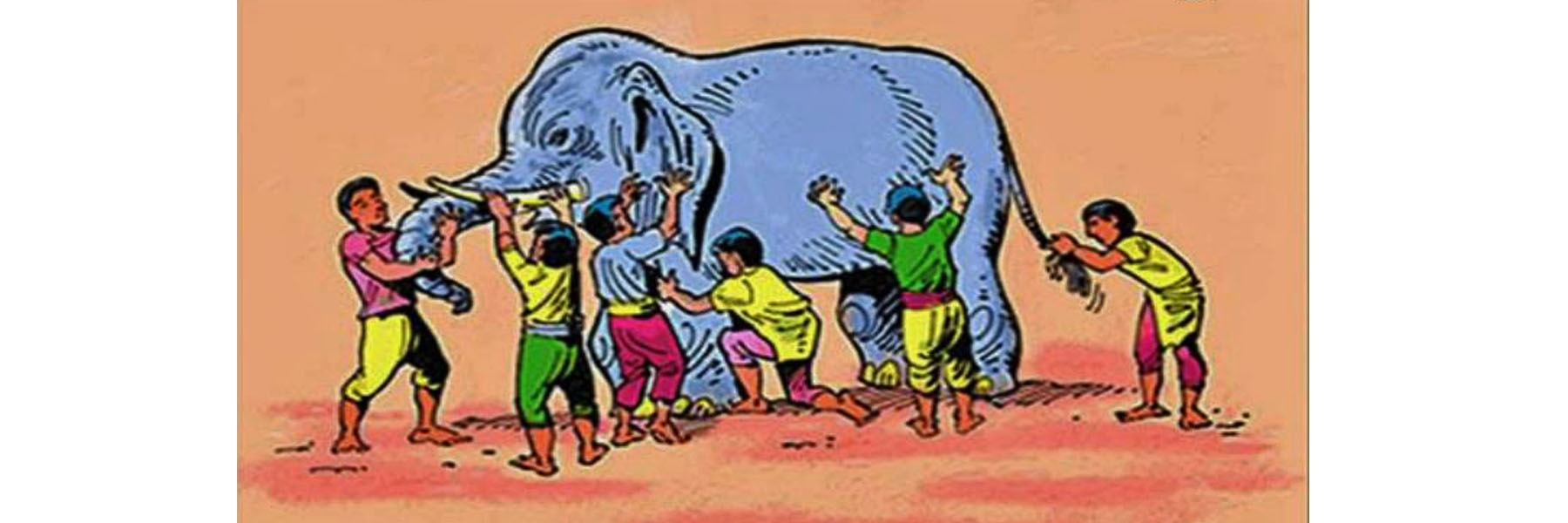Imagine nine people standing in a circle, facing inward. In the middle of that circle stands an elephant. If we were to travel around the circle asking each of those nine people about their experience, it wouldn’t be a surprise that each account would differ. The answer given by each of the nine wouldn’t simply describe the different view – the person at the top of the circle might see the head and trunk, the person at the back would see the tail etc; each of the nine would also have a different experience. Some might enjoy being so close to nature, others might be scared and daunted. This is what we call ‘subjective perception’ in the language of Humanistic psychotherapy.
And, from perception becomes interpretation and categorisation: which is what the original parable of the blind men and the elephant conveys.
Another system might enhance our understanding of subjective perception and the different ways we all see the world – that of the enneagram. The enneagram helps us understand the flavour of what these Nine different people might be experiencing; or more accurately, when presented with a similar situation, nine different ways in which we place our attention. I have been using it personally for nearly a decade now and I have found it of great value in helping me navigate my experience of being and being-in-the-world-with-others. Recently, I have been using it in my psychotherapy practice, and I believe my clients are finding it of great benefit: a system that they can use independently between sessions to get familiar with their attention focus and bias.
What is the enneagram?

 and behaving. Yet it also describes another level of our being; In Gurdjief language, as well personality there is essence. Spiritual and psychological wisdom traditions have different names for this essence – buddhanature, Self, the ground of being or fundamental consciousness to name but a few. Each and everyone one of us are of this essence, but at some time, we lost contact with this ground of being – we all know how the “fall” is depicted by Adam and Eve picking and eating an apple from the tree of knowledge. We are disconnected from our true nature, and this is the rise of personality – the enneagram describes nine ways in which we have lost contact, and how we have compensated through a particular pattern of placing our attention, a bias toward one sector of information and blind to others. The Enneagram provides a map “back home”.
and behaving. Yet it also describes another level of our being; In Gurdjief language, as well personality there is essence. Spiritual and psychological wisdom traditions have different names for this essence – buddhanature, Self, the ground of being or fundamental consciousness to name but a few. Each and everyone one of us are of this essence, but at some time, we lost contact with this ground of being – we all know how the “fall” is depicted by Adam and Eve picking and eating an apple from the tree of knowledge. We are disconnected from our true nature, and this is the rise of personality – the enneagram describes nine ways in which we have lost contact, and how we have compensated through a particular pattern of placing our attention, a bias toward one sector of information and blind to others. The Enneagram provides a map “back home”. In brief, the Nine Enneatypes have a bias in attention towards:
- Type 1: what is right or wrong, correct or incorrect
- Type 2: others’ needs, feelings and desires
- Type 3: tasks, goals and recognition for accomplishments
- Type 4: what is missing
- Type 5: accumulating knowledge, and scanning for potential intrusions
- Type 6: what could go wrong, and how to deal with worst-case scenarios
- Type 7: multiple options and idealised future plans
- Type 8: injustice, not being controlled by others, and getting things moving
- Type 9: other people’s agendas and the external environment
- Passion: the reaction to our core wounding (that normally occurred in childhood); the sense we had to be a certain way in order to survive and get our needs met
- Virtue: the higher awareness and what is expressed when we let go of the fixated passion
How does this fit into psychotherapy?
The reason I have brought this from the personal into my professional life is how often I have found the Enneagram map to be accurate. I have also found it reassuring that credible psychotherapists and clinical psychologists have equated the enneatypes with Western models: Beatrice Chestnut (Object Relations), Claudio Naranjo (Gestalt), Marion Gilbert (Somatic Experiencing), and Karen Horney’s psychoanalytic ideas find a home here.
As a Gestalt psychotherapist who works within a Humanistic and Transpersonal frame, there are two main domains in which the Enneagram finds a place. Firstly, Gestalt privileges awareness, and the work of therapy is to help a client bring awareness to what is being experienced, and rather than any notion of change, just to know oneself (and experience) fully. For example, the work with a person identifying with enneatype Six (like me) is to help them notice where in experience they are planning ahead, or where they are falling into self-doubt. Another Gestalt link is through identification of what we call ‘introjects’: a belief about what we need to do in order to get our survival needs met. As a Six, if I am loyal I believe this will keep me safe. Each enneatype has a particular introject:
- Type 1: I should be right
- Type 2: I should be helpful
- Type 3: I should be successful
- Type 4: I should be unique
- Type 5: I should be knowledgeable
- Type 6: I should be loyal
- Type 7: I should be okay
- Type 8: I should be strong
- Type 9: I should be peaceful
The second domain in which I have found a useful integration is how the Enneagram plots the arc from self to Self (what the Person Centred tradition might call actualisation, or Jungian psychology refers to as individuation). Claudio Naranjo makes the observation that in becoming unconscious to one’s essential self and to one’s adaptive strategies, one becomes unconscious to the fall from consciousness itself. That is, we develop a personality out of reacting to our environment, then we forget that we have made this adaptation. No wonder we end up identifying with our personality, thinking that it is our real self.
A note on diagnosis and labelling (and why this feels different)
I have a long-held ambivalence with labels, typings, and diagnoses – yet the perpetual movement inherent in the Enneagram model allows the fluidity of human being to be captured. There isn’t the space to go into tremendous depth here (maybe another time), but as well as mapping Type, the Enneagram also speaks to ‘wings’ (the influence of the neighbouring enneatypes e.g. as a Six, I am impacted by Five and Seven processes), travel of inner lines (where we go in times of stress and / or ease e.g. I move across the circle symbol to Nine and Three). There is also the three ‘subtype’ variations within each Type: Self-preservation, Sexual, Social. For the record, I am a self-preservation Six, so highly attuned to seeking protection and staying safe! In other words, there aren’t “Nine types of people” in which we can categorise 7.8 billion people! And yet there are patterns in our behaviour, just like movements of particles and waves can be described by quantum physics. This is an example of ‘unity and multiplicity’ that arises in various branches of philosophy: existence of a universal truth, expressed in multiple facets.
How might we use this map with clients?
I never force an agenda on clients; and I have come to introduce the Enneagram to clients very tentatively. I simply make an offering that I know a system that they might find of benefit in exploring the blocks they encounter to their full functioning. Most take up the offer, in part because they see it as something they can deepen the therapeutic work between sessions. Often they go onto introduce the system to friends and family in their lives too. Normally, I offer to send them a way of running through an Enneagram “typing test“. If they come back with an estimation of Type, we run with it; if not, I don’t mention the system again.
From experience, the Enneagram teachings help the therapeutic task in two ways. Firstly, it uncovers where there is a fixation in attention. Once this is recognised, a gap is created and a choice emerges. Secondly, with this map in hand, clients tend to develop and strengthen their inner observer. Its incredible to witness clients coming back week after week with new discoveries and realisations.
Let me give you a brief client case example. “Gemma” (not her real name) recently typed herself as a Seven. Using the Enneagram, she began to notice where her focus of attention landed – the future, and planning moments of pleasure. This was much to the irritation of her partner who complained she was always “somewhere else” and didn’t want to discuss “serious matters”. By bringing this pattern into awareness, Gemma was able to slow down, catch that impulse to “fly” and with my support, stay with the emerging experience. Gradually, as the inner observer strengthened, Gemma brought into view an underlying restlessness, one in which she feared she would be trapped and overwhelmed. In other words, her perpetual flight was in service of avoiding pain.
Another client, “Robert”, at first found it hard to take in his enneatype – a resistance that he could be fit into a “cliche pigeon hole”. We didn’t pursue it for a few weeks, but one session he brought it into the room again. A Type Three, Robert experienced quite a lot of shame around his ‘shape shifting’ persona being “exposed”. But as we talked, I explained how all 7.8 billion of us have experienced a “fall” into personality in one way or another, there are “just Nine different ways”, each with their own pattern, shadow, and way back home. In moments like this, I have no hesitation to share my own type as a Six.
The map is not the territory
I appreciate how the Enneagram provides a map – it helps us see the nature of our “fall from consciousness”. But simply knowing this doesn’t get us far – it has to be something we bring to bear. As a Six, my passion is fear and my virtue is courage. I have had to “lean in” and feel my fear in order to know fearlessness and find courage. In my experience, the Enneagram lends me a route back home; and yet we still need a vehicle that helps us directly experience the passion; to help us embody the wisdom pointed to. Sandra Maitri, one of my favourite Enneagram teachers, explains how the various spiritual traditions offer the methodologies to make the trip. I would offer that psychotherapy – if a modality that is embodied – is another vehicle.
I’m enjoying how the Enneagram helps my intention to integrate spiritual and psychological work. And, given I am completing work on my first book, maybe I have found the topic for volume 2!

